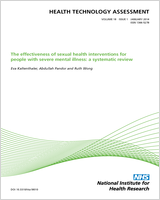Included under terms of UK Non-commercial Government License.
NCBI Bookshelf. A service of the National Library of Medicine, National Institutes of Health.
Loveman E, Cooper K, Bryant J, et al. Dasatinib, High-Dose Imatinib and Nilotinib for the Treatment of Imatinib-Resistant Chronic Myeloid Leukaemia: A Systematic Review and Economic Evaluation. Southampton (UK): NIHR Journals Library; 2012 May. (Health Technology Assessment, No. 16.23.)

Dasatinib, High-Dose Imatinib and Nilotinib for the Treatment of Imatinib-Resistant Chronic Myeloid Leukaemia: A Systematic Review and Economic Evaluation.
Show detailsChronic-phase chronic myeloid leukaemia
The PenTAG AR2 (see p. 368) concluded that effectiveness data were limited, but dasatinib and nilotinib appeared efficacious in terms of obtaining CyRs and HRs in the imatinib-resistant population. The extent to which greater frequency and/or degrees of response would impact on long-term outcomes was more difficult to conclude given the limited nature of the evidence base. In particular, only one study had compared either agent (dasatinib) with high-dose imatinib. The findings of this open-label study, that higher proportions of patients experienced positive responses to dasatinib than to high-dose imatinib, were importantly confounded by substantial crossover at an early point in follow-up.
The findings of the updated systematic review do not alter the conclusions of the PenTAG AR.2 Additional data on the clinical effectiveness of high-dose imatinib have been identified, which suggest that CyRs and HRs can be obtained in a proportion of imatinib-resistant people. However, there remains an absence of evidence with which to assess the relative effectiveness of dasatinib, nilotinib and high-dose imatinib in imatinib-resistant CML.
The uncertainties in the data mean that our exploratory cost-effectiveness analysis should be interpreted with caution. Although we have attempted to address the key areas of uncertainty in this update analysis, we do not feel able to make firm conclusions regarding the use of these technologies in chronic-phase CML patients.
Accelerated- and blast-phase chronic myeloid leukaemia
The PenTAG AR2 did not produce a de novo economic evaluation for accelerated- and blast-phase CML owing to the lack of relevant clinical effectiveness data for comparator treatments. No new evidence on dasatinib, nilotinib and high-dose imatinib was identified in accelerated or blast phase imatinib-resistant CML.
Suggested research priorities
The lack of comparative evidence hindered the assessment of the clinical effectiveness and cost-effectiveness of dasatinib, nilotinib and high-dose imatinib for people with imatinib-resistant CML. The PenTAG AR2 recommended that a three-way, double-blind, RCT of dasatinib, nilotinib and high-dose imatinib should be undertaken. It is our view that it remains a research priority to undertake a comparative study, and where feasible this should be randomised; however, we note that it is unlikely that a double-blind study could be undertaken owing to the different dosing schedules of the treatments.
- Conclusions - Dasatinib, High-Dose Imatinib and Nilotinib for the Treatment of I...Conclusions - Dasatinib, High-Dose Imatinib and Nilotinib for the Treatment of Imatinib-Resistant Chronic Myeloid Leukaemia: A Systematic Review and Economic Evaluation
- Escherichia sp. E2586, whole genome shotgun sequencing projectEscherichia sp. E2586, whole genome shotgun sequencing projectgi|1660365709|gb|VATN00000000.1|VAT 0000Nucleotide
- Conclusion - Diagnostic accuracy of the Thessaly test, standardised clinical his...Conclusion - Diagnostic accuracy of the Thessaly test, standardised clinical history and other clinical examination tests (Apley’s, McMurray’s and joint line tenderness) for meniscal tears in comparison with magnetic resonance imaging diagnosis
- Discussion - A manual-based intervention for carers of people with dementia and ...Discussion - A manual-based intervention for carers of people with dementia and sleep disturbances: an acceptability and feasibility RCT
- Study design/methods - Diagnostic accuracy of the Thessaly test, standardised cl...Study design/methods - Diagnostic accuracy of the Thessaly test, standardised clinical history and other clinical examination tests (Apley’s, McMurray’s and joint line tenderness) for meniscal tears in comparison with magnetic resonance imaging diagnosis
Your browsing activity is empty.
Activity recording is turned off.
See more...